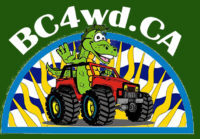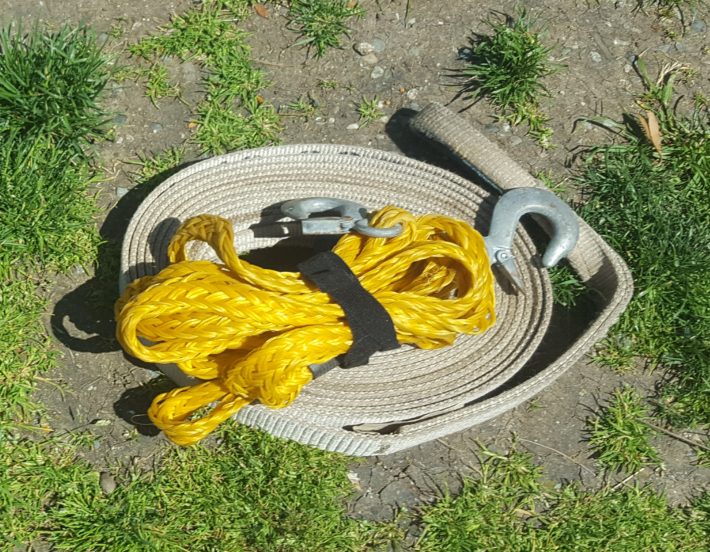Whether it's a strap, rope, chain or cable, the important differentiation is whether it is for Towing for for Recovery.
Tow ropes are designed for pulling a rolling load. Yes they can be used to gently tow a truck off a rock or out of shallow mud if they are rated high enough, but it's not their intended purpose and using them incorrectly often results in vehicle damage.
Recovery straps are elastic and are designed to stretch and then rebound when pulled on. This multiplies the force applied and reduces the "Shock Load" to both vehicles, letting you tug a bit more aggressively without damaging the vehicles (within reason). Used correctly they are invaluable. Used incorrectly they can kill.
Recovery Strap:
A good recovery strap will NOT have any type of hook on the ends, just a loop. Ideally that loop will have some sort of protective covering over it to protect from abrasion and from poorly designed tow hooks. Like all recovery gear you should be using straps rated for at least twice your vehicle weight. Remember it's not just the weight of the vehicle you need to account for, its the resistance of the mud or whatever you are stuck in.
The correct way to use a recovery strap is to have the strap securely looped onto properly rated tow points (Use a zip tie to keep it on downward facing hooks) and then take a gentle run-up against the end of the strap. Remember that your momentum is added to the weight of your vehicle, so it is not hard to get over the 8,000 to 10,000 lb rating of most tow points. Start slow and know when to give up and try something else.
What you absolutely must not do is attach to a trailer hitch ball, to a tie-down loop, to poorly welded tow points, or to any tow point not rated for at least 8,0000 lbs. You also must not use a shackle or any other heavy object to join two recovery straps together. In all these cases any failure will turn the strap into a sling-shot, launching a heavy object straight at your rig.
Just because it's a strap does not mean it is an elastic (kinetic) recovery strap. There are a lot of rigging and load-binding straps that look similar but do not have the stretch necessary to be able to take a gentle run-up and bounce against the end of the strap without damaging your vehicle from the sudden shock.
A recovery strap.
This was the first photo I remember seeing of a recovery gone wrong. Two straps were connected with a shackle, then the strap came off the stuck truck. The shackle went through the windshield, through the driver's seat, and out the back window. Miraculously the driver survived.
Join recovery straps by looping them through one another with a light object preventing the loops from locking
Recovery Rope:
Recovery Ropes are light weight, super stretchy, flexible, and very strong. Their small diameter and light weight often intimidate people who worry about their strength, however when you look at the ratings you will find they are usually over twice as strong as a similar weight strap. As with straps choose one rated for at least twice you vehicle weight. The big plus about Recovery Rope is that it is more elastic than Recovery Straps, so it reduces shock load and the extra recoil means you can do a recovery at a lower speed.
Tow Rope:
Tow ropes are one of the most often misunderstood and misused pieces of equipment. Towing means moving a rolling load, not yanking a stuck rig out of the mud. It is good to have a tow rope, but its use (if it is strong enough) is for moving a rig that is broken down but not stuck.
What you absolutely do not want to do with a tow rope is leave slack in the rope and take a rolling start in an attempt to dislodge a stuck rig. Doing this can put a shock through your rig that can cause an immediate failure in your recovery points or even cause frame damage that you may not notice.
Chain:
One challenge with chain is knowing what it is rated for. A cheap chain barely capable of towing a civic may not look that much different from "Transport" rated Grade 70 chain that can be safely used for towing a full size truck. If you don't know the rating don't use it. Chain is great for towing and very handy for looping around rocks for winching. Just remember that it is a towing/winching tool and is not designed for shock loads like a recovery strap is.
This is where a bunch of people chime in that they have been using chain or heavy duty tow ropes for jerking on stuck trucks for years, that they are used in the forestry and mining industry, and so on. When a logging truck gets stuck they are usually pulled out gently by a heavy Cat or Skidder, not jerked hard by another truck the same weight. Totally different scenario. Do it right, use items designed for towing only for rolling vehicles and a recovery strap or recovery rope for stuck trucks.








